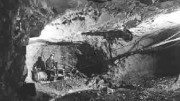The early history of hard rock mining in Ontario is essentially the story of the discovery of silver in Cobalt in 1903. It wasn’t long before the Cobalt mines became the third-largest producer of silver in the world and by the time the boom petered out in the 1920s, the camp had become the fourth-largest silver producer ever discovered.
Today, most Canadians know about the Klondike gold rush in the Yukon, but few realize that the stampede for silver in Cobalt only five years later far surpassed the Klondike in terms of profits, production, and long-term impact.
Spreading out in all directions, prospectors discovered silver in Gowganda and Elk Lake, and gold in Kirkland Lake and Timmins. These discoveries encouraged further exploration in northern Canada and beyond.

Prospectors in Cobalt, Ont., in 1904.
For the next half century, nearly every major discovery in Canada — from Noranda to Eldorado to Elliott Lake — was due to the skills and financial resources acquired at Cobalt. In the process, the foundations were laid for the establishment of an important mining industry in a part of the continent where mining had hitherto been almost unknown.
Cobalt’s contribution to Canada’s engineering, milling, industrial, manufacturing, and hydro-electric sectors explain why it is often described as “the cradle of Canada’s hard rock mining industry.”
Also nearly forgotten in Cobalt’s success story, as with many other mining booms, is the role the media played in promoting mining. Although the Ontario Bureau of Mines was eager to promote mining in the region, most mining professionals believed there were no precious metals east of the Rocky Mountains and provincial geologist Willet Green Miller, who had investigated the first discoveries in the fall of 1903, was initially unable to overcome this apathy.
It wasn’t until Miller publicized the existence of rich silver nuggets lying on the surface in articles in the Toronto Globe, the Toronto Daily Star, New York’s Engineering and Mining Journal (E&MJ) and Ottawa’s Canadian Mining Review that people began to take notice of the area. In Michigan, for example, after Charles A. Foster read Miller’s article in the E&MJ he rushed to Cobalt and discovered the Foster mine.
The following year, positive reviews in such mining and geological journals as Chicago’s Mining World and Pennsylvania’s Journal of Economic Geology kick-started the rush to Cobalt.
During the next stage of development, the Toronto press hired correspondents to write weekly accounts of the silver boom and before long there was a news bureau in Cobalt. Frank Mosure of the Toronto World was the first regular correspondent in the camp. The Financial Post commented weekly on the number of new shafts in Cobalt and detailed the growth of mining machinery and silver production. When the Montreal Monetary Times devoted its July 20th issue to Cobalt, a record 12,000 copies were sold — more than 2,000 above the journal’s normal circulation. Every day, bragged the Cobalt Nugget, “the big New York papers are giving us columns of valuable space. Only the other day the New York Telegraph had a special Cobalt edition and week by week the mining papers in Denver and San Francisco display a knowledge of the situation here that is gratifying.”
The Canadian Press Association, followed by the National Press Association of America, and the British Press Association toured the camp. These visitors enjoyed above and below-ground tours of the mines, were given samples of the rich silver ore, and later informed their readers of the area’s potential.
The editor of the London Financier proclaimed that Cobalt was “the richest silver camp in the world and alone worth a journey to Canada to see.” Another British journal, the Investors Guardian, predicted that Cobalt would become the greatest silver mining camp ever, and the Boston Financial News gushed that the camp’s “history reads like a romance. Its richness is beyond comprehension.”
Thanks to these and other accounts, by 1909 Cobalt had become a household world in North America.
The Cobalt Nugget
On a more local level, the area’s newspapers helped promote northeastern Ontario and when the silver petered out, they expanded elsewhere in the province. The Cobalt Nugget started business in 1906 as a weekly out of North Bay.
In April 1908, two employees of Haileybury’s semi-weekly Silver City News purchased the Nugget, moved it to Cobalt, and promised to promote the interests of northern Ontario. When the Nugget added another typesetting machine for faster production, the first issue of the Cobalt Daily Nugget appeared in January 1909.
Within a year its circulation increased to approximately 5,000 a day, and the newspaper was mailed to “more countries than any other small town paper,” including most American states, England, France, Germany, Norway, Sweden, Mexico, New Zealand and Australia. The paper’s editor noted that the Nugget “is so widely quoted by the big daily papers in the large cities that many of its items reach millions of readers. This kind of publicity is doing the north country a great deal of good and the results are being seen in the constantly awakening interest in this north land.”
By 1912 the Daily Nugget maintained an office in North Bay, followed the next year by regular reports from representatives in Cochrane, Elk Lake, Gowganda, Swastika, and Porcupine. The Nugget viewed itself as the spokesperson for New Ontario. It’s “only creed,” the editor claimed, was the “development and advancement of Northern Ontario.” This included providing “a fair expression of the progress and development of this north county [for less fortunate people to the south],” the “encouragement of every industry which is for the good of the district,” and presenting a united front to the provincial government at Queen’s Park in Toronto.
In conjunction with the Cobalt Board of Trade, the Nugget organized the Associated Boards of Trade of Temiskaming to represent the region before federal and provincial governments and to attract commerce and industry to the region. Northern Ontario was the land of opportunity, the Nugget proclaimed, it had the “greatest” silver, gold, and nickel deposits in the world; millions of acres of mineral land were still undiscovered; a fortune worth of timber and pulp wood awaited exploitation; eighteen million acres of farm land was ready for settlements; plus an unsurpassed climate. It “presents possibilities undreamed of in the past history of mankind.” The Nugget’s masthead indicated the town’s real priority: each day it listed the value of a bar of silver and the total production of the northern mines.
The Northern Miner
British-born Ben Wallace Hughes, the editor of the Daily Nugget, traveled to North America in 1903, and worked on a railway survey gang in New Mexico before coming to Cobalt. Hughes soon made a name for himself as a mining reporter for the Nugget, and when it became a daily he assumed the editorship.
When Hughes left the paper in 1914, Harry Browning, the managing editor, hired James McRae on a trial basis to write about what he knew best: mining. According to McRae, at that time he didn’t know how to type, but he “had intimate knowledge of men and mines,” and quickly became the papers’ mining editor.

Home of The Northern Miner in Cobalt, Ont.
When the silver began to peter out following the First World War, the Nugget returned to North Bay in 1920 and was issued semi-weekly from 1922 to 1941. In succession, the paper was owned by the Southam chain, the Hollinger empire, and the Osprey Media Group led by Michael Sifton. The Northern News, “Cobalt’s New Paper – Cobalt’s Newspaper,” replaced the Nugget in 1922 before moving to Timmins. It now publishes three times a week.
After leaving the Daily Nugget, Ben Hughes started his own weekly mining journal in Cobalt. With the assistance of printer Ernie Hand, he published the first issue of The Northern Miner in March 1915. When Hughes left the next year to prospect in Quebec, he hired Richard Pearce (1892-1972), a young reporter from the Toronto World, to edit The Northern Miner. Pearce, who had been turned down by the Canadian army in 1914 had moved to Cobalt as the World’s representative.
After marrying a Cobalt woman, Pearce purchased The Northern Miner in 1916 from Hughes, who had joined the Royal Canadian Engineers. (Hughes moved to Vancouver Island and bought the Comox Argus. Later, he founded the West Coast Advocate in Port Alberni, B.C.) At the end of the war, Pearce’s older brother, Norman, who had worked for the Toronto World and the Sunday World, moved to Cobalt as co-owner and co-editor. In 1929 the Pearce brothers brought the Northern Miner to Toronto. In 1989, the paper was acquired by Southam Business, which later sold it to Conrad Black’s Hollinger International. The Miner is now owned by Vancouver-based Glacier Media, whose primary focus is the global energy, agriculture, mining and environmental service sectors.
Cobalt was thus spawned by the print media and it gave birth to journals in Toronto, Timmins, North Bay and British Columbia.
— These stories, and more, are detailed in Dr. Douglas Baldwin’s newly published Cobalt: Canada’s Forgotten Silver Boom Town (Indigo Press, 2016) — a richly-illustrated, full-length history of Cobalt that is the culmination of four decades of research. It’s a story of immense capital accumulation, labour strife, technological progress, new government policies and ventures, regional growth, and the struggle for law and order.
Profits from the sale of this book will go to the Historic Cobalt Legacy Fund, which was created in 2014 to preserve Cobalt’s history and cultural heritage. The fund supports such organizations as the Cobalt Mining Museum, the Classic Theatre and the Cobalt Heritage Silver Trails. The book can be ordered from Nicole Guertin, Presidents’ Suites, Haileybury (Nicole.guertin@gmail.com), or from the town of Cobalt at www.cobaltboomtown.com.

Today’s Cobalt Mining Museum was the original home of the Cobalt Daily Nugget.





Be the first to comment on "Odds ‘n’ Sods : Cobalt’s silver boom and the rise of mining media in Canada"